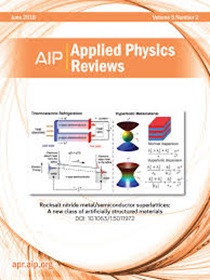Ionic conduction and interfacial stability in Na1+xZr2SixP3−xO12 solid electrolytes: Past, present, and future perspectives
IF 11.6
1区 物理与天体物理
Q1 PHYSICS, APPLIED
引用次数: 0
Abstract
While the development of new solid electrolytes (SEs) is crucial for advancing energy storage technologies, revisiting existing materials with significantly improved knowledge of their physical properties and synthesis control offers significant opportunities for breakthroughs. Na1+xZr2SixP3−xO12 (NaSICON) SEs have recently regained attention for applications in both solid-state and aqueous redox flow batteries due to their improved electrochemical and mechanical properties, along with their inherent electrochemical stability, air robustness, and low manufacturing cost. Recent improvements in NaSICON have primarily targeted macroscopic property enhancements and synthesis techniques. To enable further breakthroughs in the performance of NaSICON SEs, future efforts should focus on understanding how modified synthesis conditions influence atomic and microscopic-scale features, such as conduction channels, electronic structures, phase distributions, and grain boundaries. These features ultimately control ion conductivity, mechanical properties, and electrochemical stability of NaSICON and its interfaces. Here, we review the current understanding of the structure-chemistry-property relationships of NaSICON SEs, focusing on atomic and microscopic levels. First, we introduce the proposed ionic conduction mechanisms in NaSICON crystallites. Then, we explore experimental investigations at phase and grain boundaries to assess ionic conduction and interfacial stability. We also examine strategies to address interfacial challenges such as high resistance and chemical reactions between SEs and electrodes, highlighting the difficulties in analyzing interfaces at the nano/atomic scale. Finally, we provide an outlook on advancing microscopy and spectroscopy techniques to enhance insights into NaSICON SEs ionic conduction and interfacial stability, supporting the development of improved long-duration energy storage devices.Na1+xZr2SixP3−xO12固体电解质中的离子传导和界面稳定性:过去,现在和未来的观点
开发新的固态电解质(SE)对于推动储能技术的发展至关重要,同时,通过大幅提高对现有材料物理性质和合成控制的了解,重新审视现有材料也为实现突破提供了重要机会。Na1+xZr2SixP3-xO12(NaSICON)固态电解质由于其改进的电化学和机械性能,以及固有的电化学稳定性、空气稳定性和低制造成本,最近在固态和水氧化还原液流电池中的应用重新受到关注。NaSICON 最近的改进主要针对宏观性能的提高和合成技术。为了在 NaSICON SE 的性能方面取得进一步突破,未来的工作重点应放在了解修改后的合成条件如何影响原子和微观尺度的特征,如传导通道、电子结构、相分布和晶界。这些特征最终会控制 NaSICON 及其界面的离子导电性、机械性能和电化学稳定性。在此,我们将回顾目前对 NaSICON SE 结构-化学-性能关系的理解,重点放在原子和微观层面。首先,我们介绍了 NaSICON 晶体中的离子传导机制。然后,我们探讨了相界和晶界的实验研究,以评估离子传导和界面稳定性。我们还研究了应对界面挑战的策略,如 SE 与电极之间的高电阻和化学反应,突出了在纳米/原子尺度上分析界面的困难。最后,我们展望了显微镜和光谱学技术的发展前景,这些技术可提高人们对 NaSICON SEs 离子传导和界面稳定性的认识,从而支持改进型长效储能设备的开发。
本文章由计算机程序翻译,如有差异,请以英文原文为准。
求助全文
约1分钟内获得全文
求助全文
来源期刊

Applied physics reviews
PHYSICS, APPLIED-
CiteScore
22.50
自引率
2.00%
发文量
113
审稿时长
2 months
期刊介绍:
Applied Physics Reviews (APR) is a journal featuring articles on critical topics in experimental or theoretical research in applied physics and applications of physics to other scientific and engineering branches. The publication includes two main types of articles:
Original Research: These articles report on high-quality, novel research studies that are of significant interest to the applied physics community.
Reviews: Review articles in APR can either be authoritative and comprehensive assessments of established areas of applied physics or short, timely reviews of recent advances in established fields or emerging areas of applied physics.
 求助内容:
求助内容: 应助结果提醒方式:
应助结果提醒方式:


